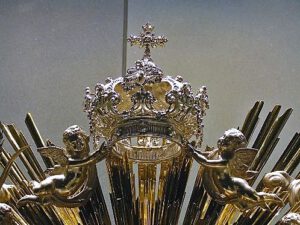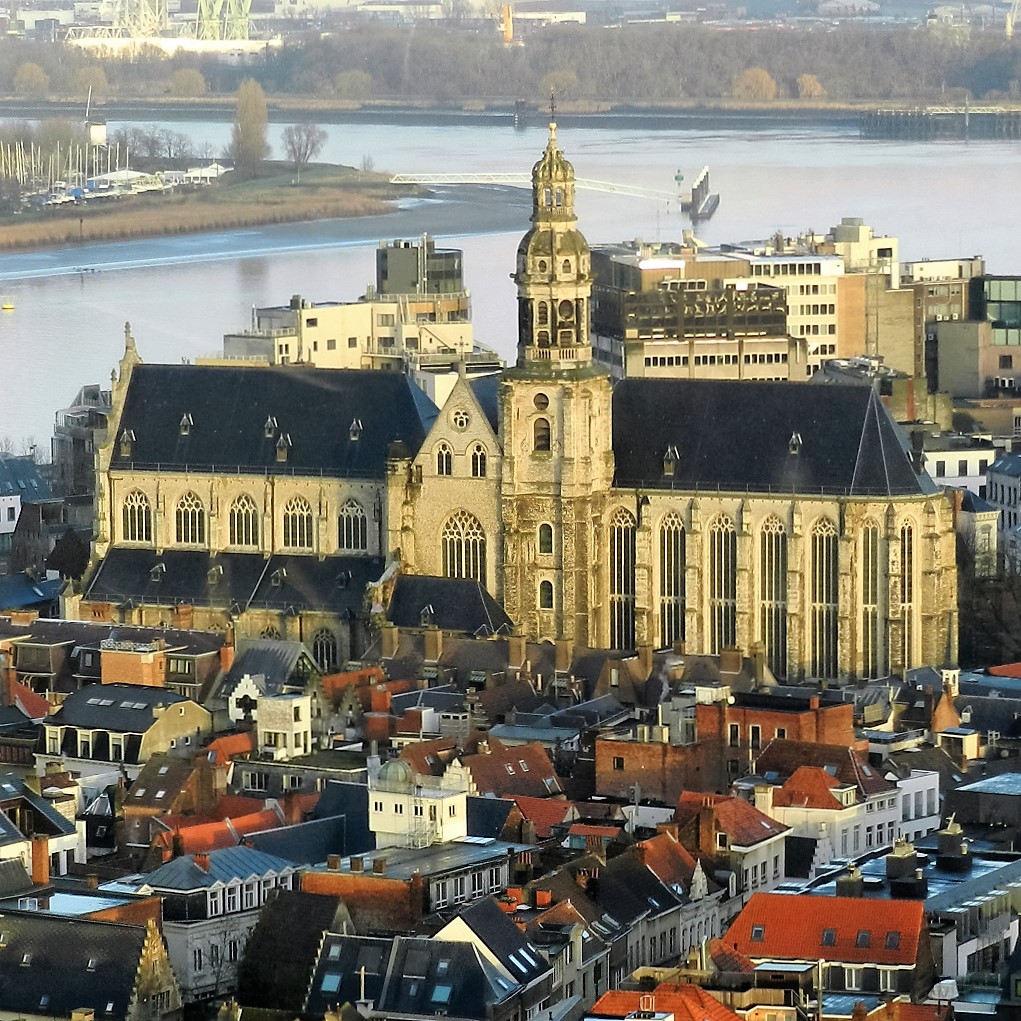Saint Paul’s, the Antwerp Dominican church, a revelation
The treasury
The treasury, which mainly contains valuable liturgical vessels, was opened in 2001. One of the ‘treasures’ is the act of consecrationIn the Roman Catholic Church, the moment when, during the Eucharist, the bread and wine are transformed into the body and blood of Jesus, the so-called transubstantiation, by the pronouncement of the sacramental words. of the first church, drawn up by Albert the Great (9th September 1276).
The sun monstranceA decorated glass holder on a base, in which a consecrated host can be placed for worship. In general, there are two types of monstrances: the ray monstrance and the tower monstrance, with the name referring to the shape of the object. The tower monstrance is very similar to the reliquary, which was very popular before the adoration of the Blessed Sacrament became widespread. with group of statues
“the Conversion of Saint PaulOriginally, he was called Saul, he was a Jew with Roman citizenship and a persecutor of Christians in the period shortly after the death of Jesus. After his conversion, he became the main gospel spreader in what is now Turkey and Greece. He wrote letters to keep in touch with the Christian communities he had founded, and these texts are the oldest ones in the New Testament. Although he never met Jesus, he is called an “apostle”.”
(J.P.A. Verschuylen, 1839)
 This neo-Baroque monstrance by the famous goldsmith Jan PetrusHe was one of the twelve apostles. He was a fisherman who, together with his brother Andrew, was called by Jesus to follow Him. He is the disciple most often mentioned In the Gospels and the Acts of the Apostles. His original name was Simon. He got his nickname Peter (i.e. rock) from Jesus, who, according to tradition, said that He would build His Church on this rock. Verschuylen (1839) is the eye catcher of the treasury. The partly gilded silver liturgical vessel weighs 10.20 kilos, including the 554 little diamonds, and sparkles by its preciousness. At least as particular is the composition and the iconography. Typical of the Baroque concept is that the sun, which is a traditional element of this type of monstrance, is used iconographically. The story of the conversion of Saul mentions that (Jesus’s) “light from the sky suddenly flashed around him.” (Acts 9:3) This light is represented as the halo around the consecrated hostA portion of bread made of unleavened wheat flour that, according to Roman Catholic belief, becomes the body of Christ during the Eucharist.. The dynamic group of statues underneath, with Saul who has fallen from his horse and with his hand protects himself from the blinding light, was inspired by the Baroque pulpit by Michiel van der Voort in St. Rumbold’s Cathedral in Mechelen. The fact that his sword (which disappeared after 1972) has been partly drawn out of its sheath, shows how much he was “still breathing murderous threats against the disciples of the Lord” (Acts 9:1). For this scene a small platform was put on the stem and as a result of this the monstrance is exceptionally tall: 3.44 ft.
This neo-Baroque monstrance by the famous goldsmith Jan PetrusHe was one of the twelve apostles. He was a fisherman who, together with his brother Andrew, was called by Jesus to follow Him. He is the disciple most often mentioned In the Gospels and the Acts of the Apostles. His original name was Simon. He got his nickname Peter (i.e. rock) from Jesus, who, according to tradition, said that He would build His Church on this rock. Verschuylen (1839) is the eye catcher of the treasury. The partly gilded silver liturgical vessel weighs 10.20 kilos, including the 554 little diamonds, and sparkles by its preciousness. At least as particular is the composition and the iconography. Typical of the Baroque concept is that the sun, which is a traditional element of this type of monstrance, is used iconographically. The story of the conversion of Saul mentions that (Jesus’s) “light from the sky suddenly flashed around him.” (Acts 9:3) This light is represented as the halo around the consecrated hostA portion of bread made of unleavened wheat flour that, according to Roman Catholic belief, becomes the body of Christ during the Eucharist.. The dynamic group of statues underneath, with Saul who has fallen from his horse and with his hand protects himself from the blinding light, was inspired by the Baroque pulpit by Michiel van der Voort in St. Rumbold’s Cathedral in Mechelen. The fact that his sword (which disappeared after 1972) has been partly drawn out of its sheath, shows how much he was “still breathing murderous threats against the disciples of the Lord” (Acts 9:1). For this scene a small platform was put on the stem and as a result of this the monstrance is exceptionally tall: 3.44 ft.
Holy Ghost pendant
(early 17th century)
Remarkable is also a child’s jewel, a small pendant in the form of a dove: a Holy Ghost pendant. The five diamond roses are very early Antwerp examples of diamonds cut in hexahedron or the form of a rose.
The portrait of Michael Ophovius
(anonymous copy after P.P. Rubens, 19th century?)
Michael Ophovius was prior of the Antwerp Dominican monasteryComplex of buildings in which members of a religious order live together. They follow the rule of their founder. The oldest monastic orders are the Carthusians, Dominicans, Franciscans, and Augustinians [and their female counterparts]. Note: Benedictines, Premonstratensians, and Cistercians [and their female counterparts] live in abbeys; Jesuits in houses., bishopPriest in charge of a diocese. See also ‘archbishop’. of ‘s-Hertogenbosch and also Rubens’s confessor.

